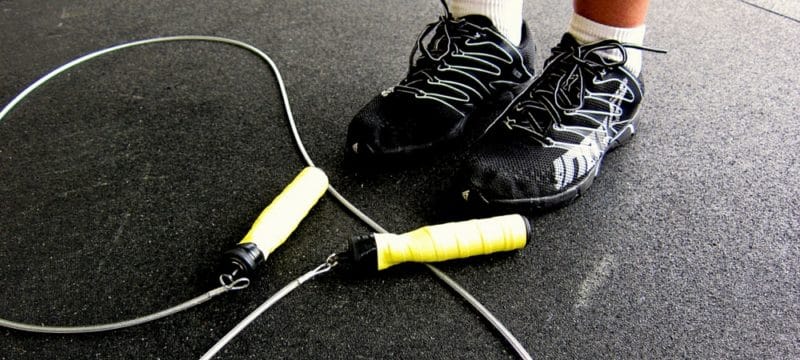You’ve seen those people at the gym, slogging away on the treadmill for hours and hours. Or standing in line for hour-long classes. Maybe you’ve wished you had time to be one of those fitness junkies.
The good news is that you don’t have to be… nor should you be.
All you need is to learn how to do interval training properly. That’s it. Doing so will save you countless hours of needless cardio and provide you with shockingly awesome fitness and health benefits.
What is Interval Training?
Interval training, also known as HIIT (High-Intensity Interval Training), uses bouts of high intensity activity followed by a recovery period.
Because you’re breaking up your intense work with bouts of recovery, you’re able to train at a higher intensity for a longer period of time, which can help you burn more fat.
The graph below gives you an idea of how your average heart rate (dashed line) increases throughout the burst training workouts. Because you don’t fully recover, notice how it inches up throughout the workout. That’s what you want for maximum fat and performance improvements.
How to Do Interval Training… The Right Way
There are thousands of possible interval protocols that you can follow, which makes it close to impossible to know where to start. So let me help you, ok?
Interval Training for Beginners:
I would generally recommend that, as a beginner, you start with a “work to rest ratio” of 1 to 4. That means, you’ll be resting 4 times as long as you work. Here are few examples of interval training workouts for beginners:
- 30 seconds of work (80-90% max effort) followed by 2 minutes recovery – repeat 5 times.
- 10 seconds @ 100% effort followed 40 seconds of recovery – repeat 6 times
- 5 seconds @ 100% effort followed by 20 seconds of recovery – repeat 10 times
Note: “Recovery” doesn’t mean that you stand around and do nothing. If you’re running, it would mean jogging instead of sprinting. If you’re doing any other form of cardio, you’d simply slow down your movement during the recovery period.
Interval Training for Intermediate/Advanced:
As you get fitter, you can shift that ratio so less time is spent recovering and more time is spent near your maximum intensity. This can reduce the duration of your workouts and greatly increase their effectiveness. Basically, the fitter you become, the lower your work to rest ratio becomes. Here’s what I mean:
1:4 <—- beginner
1: 3
1:2
1:1
2:1
3:1
4:1 <—- very advanced
For instance, many of my intervals (be it sprinting, doing kettlebell swings, jumping rope, or anything else) look like this:
Work to Rest ratio of 1:1:
- 10 seconds @ 100% effort : 10 seconds of recovery
- Repeat for 10 minutes
Work to Rest ratio of 3:1
- 1 minute @ 90% effort : 20 seconds of recovery
- Repeat for 4 minutes
This type of workout creates a substantial fat-burning effect.
During the high intensity bout, your body goes into oxygen debt. You push yourself to the limit and hold your max output for that amount of time.
Once you’ve finished, your body is thrown into recovery mode. It literally has to work to repay the oxygen debt. To do this, it draws on energy stores via fat oxidation.
However, as you can probably imagine, with intervals you never really allow yourself to fully recover. And that’s the beauty.
As you see in the above graph, your average heart rate increases over time, even though you’re throwing in recovery bouts throughout.
Unless your recovery bouts are 10 minutes long (or the like) your body will never fully recover during the workout, which means you spend more of your time closer to your maximal heart rate.
And that’s a great thing for improving all aspects of your fitness and helping your body burn more fat.
This video sums about the power of interval training:
The Science of Interval Training
Still sound too good to be true? Let’s walk through some of the hard science of high-intensity interval training.
In a 2011 recap of high-intensity interval exercise, researcher Stephen Boucher wove together a variety of studies on moderate walking and jogging, stating:
Most exercise protocols designed to induce fat loss have focused on regular steady state exercise such as walking and jogging at a moderate intensity. Disappointingly, these kinds of protocols have led to negligible weight loss.
That mid-level treadmill ride that you’ve been doing all these years? It barely moves the weight loss needle. However, after looking at study results from interval training he reports:
“Regular (interval exercise) has been shown to significantly increase both aerobic and anaerobic fitness. It also significantly lowers insulin resistance and results in a number of skeletal muscle adaptations that result in enhanced skeletal muscle fat oxidation and improved glucose tolerance.” (1)
In recent years, more and more studies have proven that fat loss happens best with interval training.
The journal Metabolism compared a 20-week endurance training program with a 15-week burst-training program and found burst trained participants lost 9x the fat as the endurance athletes. 9x! (2)
And if that’s still not enough to get you, here’s a quick run-down of other astonishing findings on interval training:
Burst Training Burns Fat for 24 Hours:
Journal Medicine and Science in Sports and Exercise – 1996
“Not only did the interval group burn more fat during exercise, but they exhibited increased fat burning effects that persisted for 24 hours after the exercise had stopped. “
Burst Training Improves Cardiovascular Endurance:
Journal of Applied Physiology – Feb 10th, 2005.
“Subjects of average beginning fitness levels performed 16 minutes of high-intensity sprinting over a two-week period. When retested after two weeks, endurance had doubled.”
Women Lose More Body Fat with Burst Training Than Aerobic Zone Training:
Journal Medicine and Science in Sports and Exercise – 2001
“Despite exercising longer and burning the same number of calories, the aerobic group lost less body fat at the end of the study than the interval group.”
Burst Training Helps You Adapt to Stress:
Dr. Jade Teta, co-author of The Metabolic Effect Diet writes:
“Cortisol is the Jekyll-and-Hyde hormone because it can be your best friend or worst enemy when it comes to fat loss. Long-duration cardiovascular exercise increases cortisol, but never breaches the intensity threshold necessary to get trigger [fat-burning hormones] like human growth hormone (HGH) and testosterone.”
Burst Training Turns Your Body into a Fat-Burning Machine:
Dr. Ben Sweeney, noted expert of Burstclub.com indicates:
“Research done on both elite and novice athletes shows that high-intensity, short-duration exercise, or burst training, actually increases your muscle building hormones like natural human growth hormone and testosterone, as well as beta endorphins (it’s ok ladies—this is a good thing!). This hormonal shift turns your body into a muscle-building, fat-burning machine.”
How to Start Interval Training
Interval training is all about reaching this higher intensity to reap the benefits of improved fitness, increased fat loss, and more.
It can be done via cardio exercise or bodyweight and strength training exercise as well. It’s all about how you set up your workout.
Here are a few ways to do interval training without cardio equipment…
1. Jumping Rope:
20 seconds @ 100% effort : 40 seconds @ recovery pace x 5 (5 minutes)
=> More examples here.
2. Burpees
30 seconds @ 100% effort (the burpees) : 30 seconds recovery (jogging on spot) x 5 (5 minutes)
3. Quick Steps (6-8 inch step)
10 seconds @ 100% effort : 20 seconds recovery (nice and easy stepping) x 10 (5 minutes)
A lot of the research seems to indicate that the benefit comes from giving it everything you’ve got during the work bouts. Thus, longer work bouts (more than 1 minute), although still beneficial, may be less effective than short 5-20 second all-out efforts, especially for burning fat. After all, you can only go all-out for so long, right?
Here are a few interval training routines you can try:
How Long Should an Interval Workout Last?
Different levels of fitness require different lengths of training. Here’s a basic rundown of how to do interval training at your current level of fitness. In general, you only need about 5 minutes of intervals to reap its benefits.
Yes, just 5 minutes.
Below is a bit more on how often to do interval training.
Beginner
If you exercise less than 2x per week, are very overweight, or are largely sedentary, you’ll want to warm up properly before ever trying interval training. The high-intensity can be pretty demanding, so jumping straight into high-intensity exercise should be put off until you can consult with a physician.
Intermediate
If you’re already exercising 2-4 times weekly, swap in burst training 1-2 times per week. On off days, enjoy some low intensity cardio like walking, cycling, or elliptical to help your body recover.
Advanced
If you’re already exercising 4x per week or more, 1-2 sessions of those sessions can be or include interval training. Please remember that using burst-style training completely removes the necessity to do long, drawn out cardio sessions.
Even if you’re doing bodyweight exercises or strength training within an interval set up, your heart will be pounding—a sign you’re getting a seriously good cardio workout. This video goes into more depth.
A Basic High Intensity Interval Training Routine for You to Try
So are you ready to try it?
Here’s a great starter routine. And to make things even easier, I’ve created a free Interval Training 1-page printable plan. Just scroll down and you can download it instantly at the bottom of this post.
Warm up with light aerobic activity + dynamic exercises – 3 to 5 minutes
- Interval 1: Push-Ups for 30 seconds – rest for 30 seconds
- Interval 2: Running in Place for 30 seconds – rest for 30 seconds
- Interval 3: Bodyweight Squats for 30 seconds – rest for 30 seconds
- Interval 4 : Jogging in Place with High Knees for 30 seconds – rest for 30 seconds
- Interval 5: Mountain Climbers 30 seconds – rest for 30 seconds
Cool down with foam rolling – 3 to 5 minutes
Some exercise enthusiasts argue there’s a special ratio of “Burst to Rest time” that you must do in order to receive the full benefits.
Don’t worry about too many specifics, especially if you’re getting started.
Beginners will want to be lenient with their active recovery times at first. Then, once more comfortable, push themselves with longer bursts and shorter active recovery times.
Enjoy This Article?
Did you enjoy this article on How to Do Interval Training?
You might also like my free Interval Speed Burst Workout that burns more fat than cardio, while also improving your cardio endurance. Click the banner below to get it for FREE.








